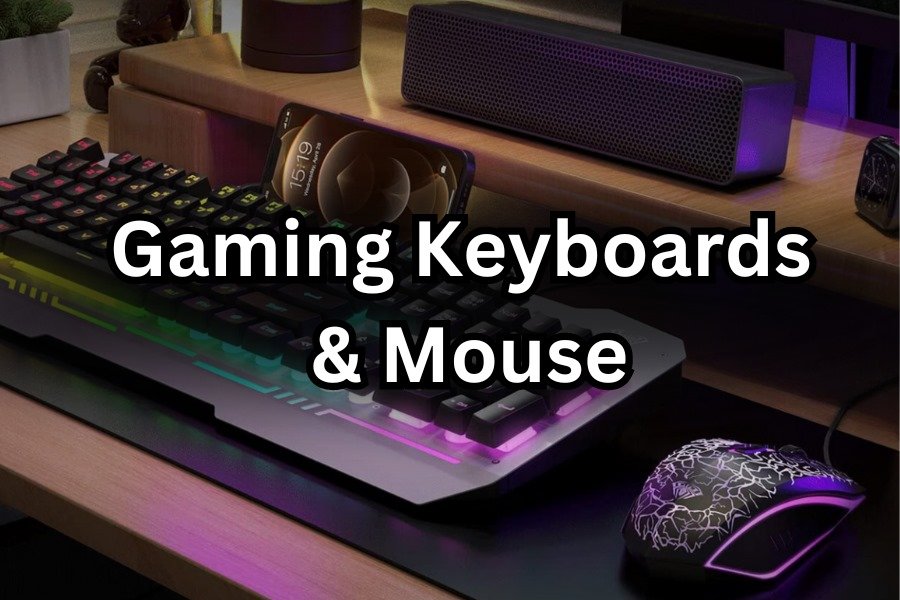Gaming peripherals, specifically keyboards and mice, are crucial for an immersive and competitive gaming experience. As the gaming industry evolves, so do the technologies embedded in these devices. Here’s a comprehensive look at the top features to look for in gaming keyboards and mouse to ensure you make the best choice for your gaming setup.
Gaming Keyboards
- Mechanical vs. Membrane Switches
- Mechanical Switches: Preferred for their tactile feedback, durability, and speed. Popular switches include aula’s KRGD Blue, AULA S2022U Wired Mechanical Gaming Keyboard.
- Membrane Switches: Quieter and less expensive but often less responsive and durable compared to mechanical switches.
- Key Rollover and Anti-Ghosting
- N-Key Rollover: Ensures that multiple keys can be pressed simultaneously without missing any inputs.
- Anti-Ghosting: Prevents unregistered or “ghost” keys from being detected when multiple keys are pressed simultaneously.
- Backlighting and RGB Customization
- RGB Lighting: Offers extensive customization with millions of colors and various lighting effects. Allows for aesthetic personalization and visual feedback during gameplay.
- Single-Color Backlighting: Simpler and often more budget-friendly, providing adequate illumination in low-light conditions.
- Programmable Keys and Macros
- Macro Keys: Dedicated keys for complex commands or sequences, enhancing efficiency and gameplay.
- Programmable Keys: Allow for customization of key functions to suit specific gaming needs.
- Build Quality and Design
- Material: Look for high-quality materials like aluminum or reinforced plastic for durability.
- Ergonomics: Consider wrist rests, adjustable feet, and overall comfort during long gaming sessions.
- Software Integration
- Customization Software: Allows for key remapping, macro creation, and lighting customization. Popular software includes Razer Synapse, Corsair iCUE, and Logitech G Hub.
- Additional Features
- USB Passthrough: Provides extra USB ports for easy access to other peripherals.
- Dedicated Media Controls: Convenient for adjusting volume, skipping tracks, or muting audio without leaving the game.
Gaming Mouse
- Sensor Quality
- Optical Sensors: Known for precision and reliability. Popular choices include the AULA Gaming Mouse F820B and AULA S11 Wired Gaming Mouse.
- Laser Sensors: Can work on a variety of surfaces but may have issues with acceleration and precision compared to optical sensors.
- DPI (Dots Per Inch) and Sensitivity
- High DPI Range: Allows for precise cursor movements and quick adjustments. Look for mice with a wide DPI range, from 200 to 16,000+ DPI.
- On-the-Fly DPI Adjustment: Enables changing DPI settings instantly for different gaming scenarios.
- Ergonomics and Design
- Grip Style: Consider your preferred grip style—palm, claw, or fingertip—and choose a mouse that complements it.
- Weight and Balance: Some mice offer adjustable weights to find the perfect balance for your playstyle.
- Buttons and Customization
- Programmable Buttons: Additional buttons can be mapped to in-game commands or macros for increased efficiency.
- Scroll Wheel: Look for a durable and responsive scroll wheel, with some models offering customizable resistance.
- Build Quality and Durability
- Materials: High-quality plastic or metal construction ensures longevity.
- Switches: Durable switches like Omron are favored for their reliability and lifespan.
- RGB Lighting and Aesthetics
- Customizable RGB: Enhances the visual appeal and can be synchronized with other RGB components.
- Aesthetic Design: Consider a design that complements your overall gaming setup.
- Wireless vs. Wired
- Wireless Mice: Offer freedom of movement and a cleaner setup. Look for low-latency options like Logitech Lightspeed or Razer Hyperspeed.
- Wired Mice: Provide consistent power and response time without worrying about battery life.
- Software Integration
- Customization Software: Essential for button mapping, DPI settings, and lighting effects. Ensure the software is user-friendly and offers comprehensive customization options.
Conclusion
Selecting the right gaming keyboard and mouse involves considering various features that cater to your specific needs and preferences. Mechanical switches, key rollover, and RGB customization are vital for keyboards, while sensor quality, DPI range, and ergonomic design are crucial for mice. Prioritize build quality, additional features, and software integration to enhance your gaming experience.
Investing in high-quality peripherals not only improves performance but also ensures durability and comfort during long gaming sessions. Whether you’re a casual gamer or a competitive esports player, the right keyboard and mouse can significantly impact your overall gaming experience.




